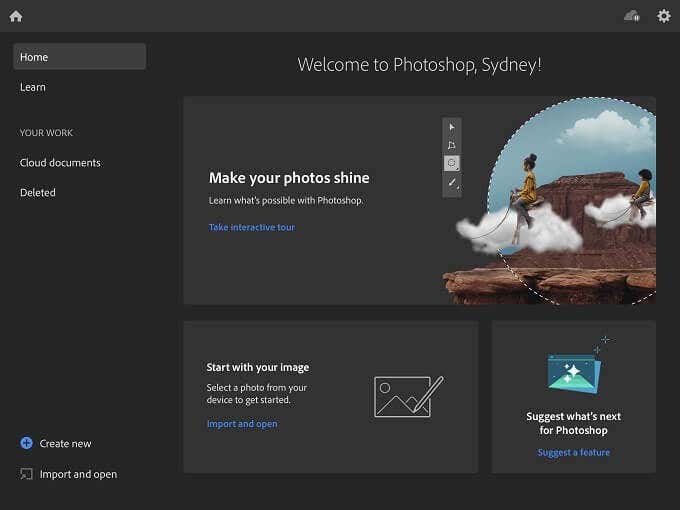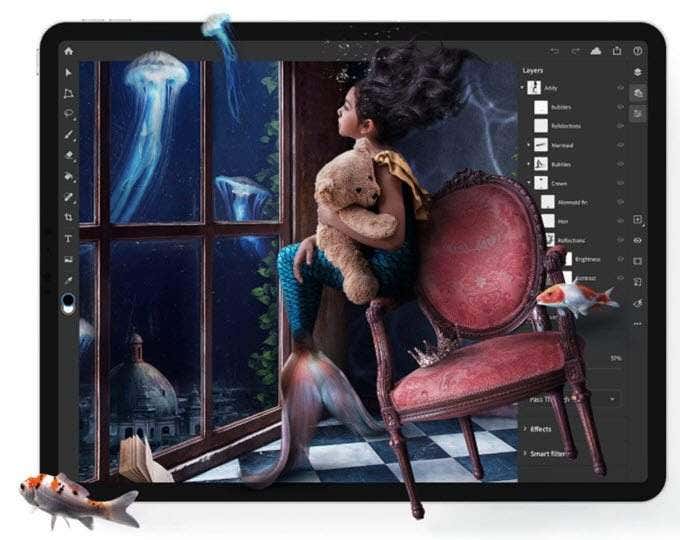Apple has been pushing their iPads (especially the iPad Pro) as a replacement for traditional laptops and even desktops for some time now. With the release of iPadOS, Apple has made perhaps the largest push to give iPads the same range of capabilities as you’d find in a laptop.
While iPadOS is pretty fantastic and delivers on most of the promises geared towards making it your only computer, we still need software developers to step up and provide applications that give us the same sort of feature set as their desktop counterparts.

For example, LumaFusion is an iOS app that provides the same functionality as desktop video editors. You could 100% use it as your only video editor. It’s not a “mobile” or “lite” approach to creating an application for tablets.
This is why everyone in the photo-manipulation community has been waiting in great anticipation for the desktop version of Adobe Photoshop to arrive on iOS, ever since it was first announced at Adobe’s conference about a year prior. Now it’s here and you might be wondering if it’s worth it to use this version of Photoshop for iPad. Let’s look at the most salient points.
Pricing
When we ask “is something worth it?” it often means “is it worth the money?”. That’s complicated when it comes to Photoshop for iPad since Adobe has long ago abandoned the one-off software sale model.
The only way to get Photoshop is to subscribe to their Creative Cloud service. The cheapest version, which includes Photoshop and Lightroom, will run you $10 a month. However, it’s an annual contract. This means you are on the hook for $120 per year if you choose to pay monthly. Early cancellation is possible, but it comes with penalty conditions.

So off the bat, Photoshop for iPad is a hard sell as a standalone application on iOS. However, if you’re already subscribed to a Creative Cloud plan that includes the desktop version of Photoshop, you also already have this app. Just download it and log in.
See why this is complicated? It’s an expensive app by itself, but essentially a free add-on if you’re already a Photoshop user. If you aren’t already a Photoshop user, you aren’t really the target for this application. So we’ll look at it from the perspective we expect most users to have.
The Promise Of “Full” Photoshop for iPad
What does it mean for Adobe to bring “full” desktop Photoshop to iPad? Well, it doesn’t mean that there is feature parity between the two versions. Version 1.0 of Photoshop for iOS lacks many features that are in the desktop version. Those will come in time – to a point – but right now it doesn’t seem like Adobe is providing an alternative to desktop Photoshop.
So what makes it comparable to the desktop version at all? The key fact here is that this uses the same code as the desktop version. At its core, Photoshop for iPad is the same application. This raises hope that Adobe can, with relative ease, add more of the parent application’s features. Something which they have already started doing.
Focusing On “Common” Tasks
Adobe seems to be focusing on the most common Photoshop workflows and functions. Especially ones that users are most likely to need in a mobile context.
If you’re a current user of Photoshop on desktop, then it’s a good idea to check whether tools that are essential to your current workflow are already in the app.
Features Missing In Action

By the time you read this, Adobe may have rectified some of the more urgent missing features in their app, but at the time of writing, there’s a sizable list of things desktop users may miss in the tablet version of Photoshop.
Relatively advanced features, such as animation, aren’t to be found in the iPad version of Photoshop. Likewise, there doesn’t seem to be RAW image editing support. This is a real shame since modern USB-C iPads make it a doddle to directly transfer photos from a camera to the tablet on the go.
You also won’t find the advanced selection tools, custom brushes, or other more specialized features of desktop Photoshop here. At least not yet. This is a rudimentary implementation of Photoshop, and only time will tell how close Adobe will push the iOS version of Photoshop to its desktop parent.
Procreate & Affinity Photo: A Better Alternative?

The big problem with Photoshop for iPad is that other developers have been developing their iOS photo manipulation apps for years. They might have had a mobile-first approach and don’t have the impressive code and technology behind Photoshop, but they’ve targeted the vacuum left by Adobe hard.
Procreate has become the gold standard for drawing on iOS. Adobe has now also released Fresco, but we have to compare it to the drawing functionality in Photoshop since that’s a large part of the appeal.
Affinity Photo has been acting like the answer to Photoshop’s gap on iPad. It bills itself as a “desktop-grade” photo editing app for iPad and given the general responses of users, it certainly seems to do the job.
In both cases, however, these apps have a major advantage over Photoshop simply because they are so much more affordable. While Photoshop will cost you at least $120 a year if paid monthly, both Procreate and Affinity are once-off purchases. They aren’t particularly expensive either, which makes Photoshop a pretty hard sell.
The Bottom Line
So, at the time of writing, we can make a few recommendations about Photoshop for iPad. If you are not currently subscribed to Adobe Creative Cloud and want to have desktop-grade photo editing on your iPad, you’re better off buying an established app like Affinity Photo.

If, on the other hand, you already have an Adobe CC subscription that includes Photoshop, you’re getting the iPad version for no extra money. In which case you may find that the cloud-based file sharing between your desktop and tablet could be a real boon. You could do basic prep work on photos on the fly, and then sit down to do the advanced stuff, which saves a lot of time.
If you’re someone who has replaced their laptop or desktop with an iPad, then Photoshop for iPad isn’t ready to become your one and only photo editor. Once again, you’re better off going with the established iPad-first applications.
With more features and perhaps the option to buy the application once-off on iOS, that recommendation could change. For now, it’s better to wait and see.